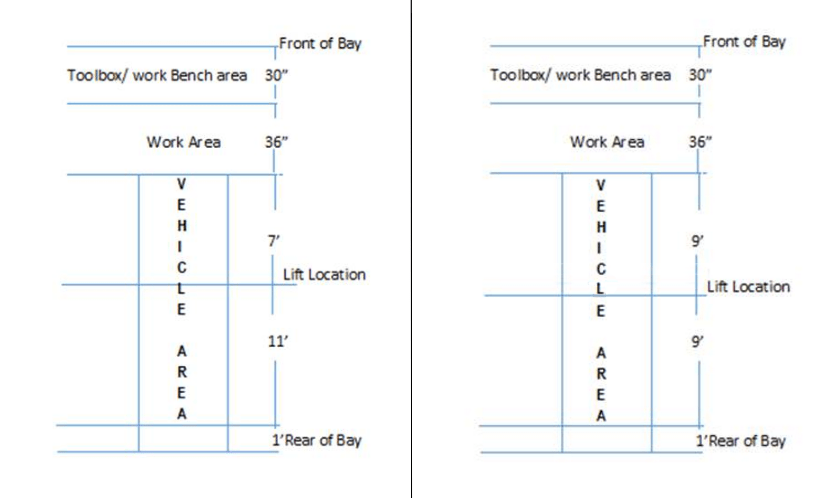Lift Installation Guide
The first part of a successful lift installation is the location of the lift within the bay. It is a good idea to allow for at least a 18′ Vehicle. If you are working on larger vehicle you must take that into consideration. Most often, a work bench or tool box will be in the front of the bay. This typically requires a 30″ space in the front of the bay.
You will also need a work space between the bench/tool box area and the vehicle. Moreover, you may need to maneuver an engine crane in that area. Also to consider is a roll larger for A/C or diagnostic equipment in that area. A 3′ space must be provided in front of where the vehicle will sit.
Determine if you require a symmetric or an asymmetric lift design will be used. The asymmetric design is the most popular, as it allows greater door opening and easier positioning of the arms. A vehicle of 18′ length on an asymmetric lift will have 7″ of the vehicle forward of the column and 11′ of the vehicle behind the column.
The asymmetric design has both arms on folding in the same direction, this is helpful with shorter wheel base vehicles. You may work with a lot of heavy vehicles. Therefore for a vehicle with unbalanced weight, an asymmetric lift with 4 equal length arms is better for balance. This design allows for a greater drive through clearance as the arms on each side are stored in opposite directions. Another benefit of the symmetric design is it can be entered from either direction.
To position a 18′ vehicle on a symmetric lift, 9′ of the vehicle will be in front of the column and 9′ of the vehicle will be behind the column. It is recommended that a 1′ space is left behind the vehicle to allow closing the garage door.
Consider the ceiling height, because most lifts have an overhead height of just under 12′. This is done to allow installation under a 12″ ceiling, which is common in the industry. If you have a higher than 12″ ceiling and work on larger vehicles, consider an extended height model in order to allow full rise with a full size van or box truck. A full size van normally requires an overhead height of 12’6″ to 13′ to go full rise. In conclusion, a box vehicle normally requires 14 ” ceiling height.
If the ceiling is lower than 12″ a floor plate design may be required. There is a little less convenience if using a rolling oil drain or transmission jack. This is because a plate must cover the equalization cables and hydraulic hoses connects the columns across the floor and normally is 1 ½ ” high. The minimum ceiling height that a low profile vehicle can be fully raised under is approximately 10-6′
Other features to consider
- Single point lock release – a lock design that releases both locks from one column
- Truck extensions – an adapter set to allow the pads to connect the frame without the arms contacting grounds effects and running boards
- Capacity-10,000 is the industry standard to allow servicing most cars arm light trucks
- Certification- ETL-Equipment Testing laboratory— ALI- American lift institute and ANSI-
- American national standards institute, these 3 recommended certifications will ensure safe and reliable operation
- 2-1 drive or 1-1 drive – the chain (2-1) lifting is not as efficient as the direct drive style. Because the 2-1 style moves 1″ for every 2 “. Therefore the vehicle is raised and has a chain roller on top of the cylinder. Moreover, the chain has many links where a problem could arise. With the 1-1 style the cylinder is inverted and pushes off the floor or pulls from overhead, the cylinder is connected to the carriage and eliminated the need for a chain. The 1-1 system does use an equalization cable. Most of all, this will keep both sides even if a vehicle is placed off center or it is unbalanced side to side.
- 3 stage arms- this is a feature that allows more adjustability of the arm pad placement. This feature allows you lift to pick up a vehicle symmetrically or asymmetrically to better accommodate cars and trucks on 1 lift.

